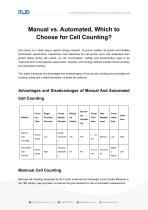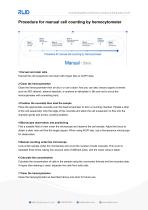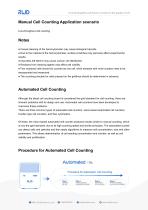 Website:
RWD Life Science
Website:
RWD Life Science
Catalog excerpts

Manual vs. Automated, Which to Choose for Cell Counting? Cell culture is a critical step in cellular biology research. To ensure healthy cell growth and facilitate downstream experiments, researchers must determine the cell growth curve and understand their growth status during cell culture, so cell concentration, viability and concentration need to be measured prior to downstream experiments. Typically, cell counting methods include manual counting and automated counting. This article introduces the advantages and disadvantages of manual cell counting and automated cell counting, along with a detail introduction of these two methods. Advantages and Disadvantages of Manual And Automated Cell Counting Manual Cell Counting Automated Cell Counter Single Accuracy Labor Cost Mannual Cell Counting Mannual cell counting, developed by the French anatomist and histologist Louis-Charles Malassez in the 18th century, has long been considered the gold standard for cell concentration measurement.
Open the catalog to page 1
Procedure for manual cell counting by hemocytometer 1 Harvest and stain cells Harvest the cell suspension and stain with trypan blue or AO/PI dyes. 2 Clean the hemocytometer Clean the hemocytometer then air dry it or use a dryer. And you can also choose organic solvents such as 95% ethanol, ethanol absolute, or acetone to dehydrate it. Be sure not to scrub the hemocytometer with something hard. 3 Position the coverslip then load the sample Place the appropriate coverslip over the haemocytometer to form a counting chamber. Pipette a drop of the cell suspension onto the edge of the coverslip...
Open the catalog to page 2
Manual Cell Counting Application scenario Low-throughput cell counting Notes ● Casual cleaning of the hemocytometer may cause biological hazards. ● Due to the material of the hemocytometer, surface scratches may seriously affect experimental results. ● Impurities left behind may cause uneven cell distribution. ● Residues from cleaning agents may affect cell viability. ● Few clustered cells should be counted as one cell, while samples with more clusters need to be resuspended and measured. ● The counting principle for cells pressed on the gridlines should be determined in advance. Automated...
Open the catalog to page 3
(1) Harvest and stain cells. (2) Load the sample onto a disposable counting slide. (3) Insert the slide into the instrument. (4) The instrument displays the count results immediately. Automated Cell Counting Applications High-throughput cell counting. Automated cell counters can be used with various types of optical equipment and can therefore be upgraded to fluorescence automated cell counters for direct AO/PI dual fluorescence. Notes (1) Counting parameters should be set based on the sample. (2) The predilution multiplier should be entered in advance. (3) The accuracy of the autofocus...
Open the catalog to page 4
Pharmacopeia-National Formulary (USP-NF) recommends the use of at least two or more methods to determine cell viability after recovery. In addition to brightfield trypan blue staining, the AO/PI staining method is commonly used for fluorescence-based live cell counting. Therefore, an automated cell counter with fluorescence capabilities is more convenient for both brightfield and fluorescence-based cell counting, making it more suitable for current cell biology research scenarios.
Open the catalog to page 5All RWD Life Science catalogs and technical brochures
-
RWD Gradient Thermal Cycler
2 Pages
-
Rotary Microtomes S710
2 Pages
-
RWD Osmotic infusion Pump
2 Pages
-
RWD Syringe Pump R462
1 Pages
-
RWD Rotating impactor 68099Ⅱ
2 Pages
-
RWD Microcentrifuge M1324R
2 Pages
-
RWD Infusion imager RFLSI Ⅲ
2 Pages
-
RWD Surgical Instruments
18 Pages
-
RWD Veterinary medical equipment
32 Pages
-
RWD R415 Animal Ventilatorr
1 Pages
Archived catalogs
-
PRODUCT CATALOGUE 2017
51 Pages
-
2015 Product Catalogue
44 Pages


















































































